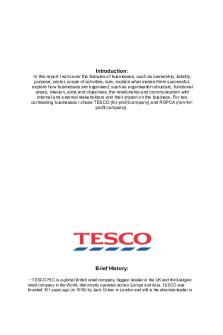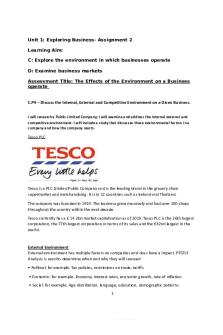Unit 1- Exploring Business PDF

| Title | Unit 1- Exploring Business |
|---|---|
| Course | BTEC Business Level 3 |
| Institution | Halesowen College of Further Education |
| Pages | 8 |
| File Size | 58.2 KB |
| File Type | |
| Total Downloads | 71 |
| Total Views | 201 |
Summary
Exploring Business with Questions and answers...
Description
Unit 1- Exploring Business Complete Revision Questions and Answers Learning Aim A - Explore the features of different businesses and analyse what makes them successful Q. What is the economy? A. An economy is a system of making and selling things of value. These things are usually in one of 2 categories - products (tangible items such as toilet roll) and services (something done by people such as business consulting). Q. What are the different sectors in the economy? A. The primary sector covers raw products, like farming and mining. The secondary sector covers the manufacturing of goods. The tertiary sector covers a range of services provided to people and companies. Q. What is a sole trader? A. A sole trader is a self-employed person who owns and controls their own business by themselves. ● Some people say that as a sole trader, you are the business. ● As a sole trader, you have complete control over your business, assets, and profits. ● Unlike a limited company, a sole trader is individually liable for their business’s debts. Their assets may be at risk if they cannot pay creditors. ● There is no obligation to register the firm with Companies House or make filings of information with them. ● Sole traders have to report and pay tax to HMRC through a self-assessment form once a year. Q. What is a general partnership? A. A general partnership provides a simple way for two or more people to own and manage a company together, contributing resources, skills and time – similar to how a single person can operate a business as a sole trader.
Q. What does liability mean? A. Liability is the state of being legally responsible for something, such as the debts of a business. ● A company can have limited or unlimited liability. Q. What is the difference between limited and unlimited liability? A. As a company with limited liability, your assets are safe from debt; however, your assets are not safe with unlimited liability. Q. What is revenue? A. Revenue is the income earned by a business for selling its products and services. Q. What does FTSE stand for and what is it? A. FTSE stands for The Financial Times Stock Exchange. ● It is a share index of the 100 companies with the highest market capitalisation listed on the London Stock Exchange. Q. What is freedom of entry? A. A business has the freedom of choosing to enter and leave the market due to an unlimited number of buyers and sellers. Q. What are two examples of non-profit businesses? A. - Voluntary - Acorn Children's Hospice - Charitable trust - The Princes Trust Q. Name the purpose of business and Explain how it varies between business types A. The purpose of business is to provide products and services. ● For-profit businesses aim to make as much money as possible and forward these profits to stakeholders. ● Non-profit businesses aim to meet societies needs, such as housing or education. Q. What is the scope of a business? A. Any business's scope involves every activity performed by that business, including sales, services, product developments, marketing, and contracts. ● Business scope refers to all business operations, particularly those required to secure revenue.
● The scope can be on a local, national or international scale. Q. What the reasons for the success of sole traders and smaller partnership businesses? A. They can easily meet the needs of the local or national area and can provide more personalised services. ● They can also build closer relationships.
Q. What are the reasons for the success of large enterprises? A. They can charge lower prices due to scale benefits lowering the cost per unit. They also have more extensive advertising and marketing expertise and budgets. Q. Name some examples of internal stakeholders and their influence on the business. A. 1. Employees can increase or decrease the amount of work they do this will lead to productivity and profits changes. 2. Managers make important decisions on behalf of the company - this can influence whether the business is thriving. 3. Owners choose to invest more money to grow the business; they can also make essential business decisions. Q. Name some examples of external stakeholders and their influence on the business. A. 1. Customers - They can increase or decrease the number of products they buy or the services they use - this will result in a change in profits. 2. Banks or lenders - They can give loans to businesses - this enables businesses to grow, but they can also increase interest rates. 3. Government - They can award grants to a business - this can help them grow, but they can also increase or introduce new taxes for businesses. 4. Suppliers - They could increase the cost of raw materials - this means a business may have to increase the price it charges consumers or accept a decrease in proceeds. Q. Name the written forms of communication in business and why they are important
A. These can be financial or non-financial reports that can be formal or informal. ● They also use a letter to communicate and more modern methods such as the internet and messaging. Q. Name a type of oral communication in business. A. - Presentations - Pitches - Speeches - Meetings - Discussions Q. What are the advantages of oral communication? A. There is a high level of understanding and transparency in oral communication. ● The feedback is spontaneous in the case of oral communication. You can make decisions quickly. ● Oral communication saves time and money.
Learning Aim B - Investigate how businesses are organised Q. Name the types of organisational structures. A. - Hierarchical - Matrix - Flat - Holocratic Q. What is the hierarchical organisational structure? A. A hierarchical structure has many management layers. ● Businesses with this structure often use a ‘top-down’ approach with a lengthy chain of command. ● In a hierarchical structure, managers will have a slim span of control and a small number of subordinates (staff). Q. What is the matrix organisational structure? A. Matrix management is an organisational structure in which some individuals communicate to more than one supervisor or manager. Q. What is the flat organisational structure? A. A flat structure is a structure with only a few layers of management.
● In a flat structure, managers usually have a wide span of control with more staff, and there is usually a shorter chain of command. ● Smaller businesses commonly use flat organisational structures. Q. What is the holacratic organisational structure? A. A holacracy is a system for running a company where there are no designated roles, and employees have the flexibleness to take on many tasks and move between teams easily. Q. What does SMART mean in terms of objectives? A. Specific Measurable Achievable Realistic Time-based
Learning Aim C - Examine the environment in which businesses operate Q. What does PESTEL stand for? A. Politics Economic, fiscal and monetary government policies Social attitudes to saving, spending and debt Technological change Environmental factors and ethical trends Legal environment Q. Give examples of each letter in PESTEL A. P - Government support, membership of trading companies such as the European Union E - Supply-side policy, economic growth and exchange rates S - Social responsibility requirements, customers tastes and preferences, demographic trends T - Automation, improved communications E - Carbon emissions, waste and pollution L - Companies acts, legislation, industry regulators
Q. What is corporate culture? A. Corporate culture refers to the opinions and actions that determine how a company's employees and executives interact and manage outside business transactions. ● Often, corporate culture is suggested, and not defined, and develops naturally over time. Q. What are the factors affecting competitive advantage? A. Differentiation, pricing policies, market leadership, reputation, market share, suppliers, employees and cost control. Q. What are the benefits of maintaining a competitive advantage? A. A competitive advantage separates a company from its competitors. ● It contributes to higher prices, added customers, and brand loyalty. ● Building such an advantage is one of the most critical goals of any company.
Learning Aim D - Examine Business Markets Q. What is perfect competition? A. Perfect competition is a market structure in which the following criteria are met: ● All businesses sell identical products. ● Market share does not affect prices. ● Resources for labour are entirely mobile. ● Firms can enter or exit the market without cost. Q. What are the influences on demand? A. Influences on demand include: ● Affordability ● Competition ● Availability of substitutes ● Needs of customers ● Aspirations of customer
Q. What influences supply? A. Influences on supply include : ● Availability of resources ● Availability of labour ● Logistics ● Competition ● Government support
Learning Aim E - Investigate the role and contribution of innovation and enterprise to business success Q. What is innovation? A. Innovation is the development and utilisation of ideas that improve the way things are done or what can be accomplished. Q. What are some examples of innovation? A. 1. Developing products 2. Improving profitability 3. Adding more value to products Q. What is 'blue-sky thinking'? A. It is approaching problems with no restrictions on perspectives. Q. What is lateral thinking? A. Approaching dilemmas from alternative perspectives. Q. What are the benefits of innovation and enterprise? A. The benefits include: 1. Improvements to products 2. Business growth 3. Development of new markets 4. Offering unique selling points 5. Smarter working Q. What does USP stand for? A. It stands for Unique Selling Point
Q. What are the risks of innovation and enterprise? A. The risks are: 1. Failing to meet commercial requirements 2. Failing to achieve a return on the investment 3. Cultural problems such as resistance to change...
Similar Free PDFs

Unit 1- Exploring Business
- 8 Pages

Unit 1-Exploring the business
- 10 Pages

Assignment 1 - Exploring Business
- 16 Pages

Business Unit 1 Booklet
- 9 Pages

Higher Business Unit 1
- 136 Pages

business organization unit 1 notes
- 14 Pages

Complete unit 1 - Business course
- 32 Pages
Popular Institutions
- Tinajero National High School - Annex
- Politeknik Caltex Riau
- Yokohama City University
- SGT University
- University of Al-Qadisiyah
- Divine Word College of Vigan
- Techniek College Rotterdam
- Universidade de Santiago
- Universiti Teknologi MARA Cawangan Johor Kampus Pasir Gudang
- Poltekkes Kemenkes Yogyakarta
- Baguio City National High School
- Colegio san marcos
- preparatoria uno
- Centro de Bachillerato Tecnológico Industrial y de Servicios No. 107
- Dalian Maritime University
- Quang Trung Secondary School
- Colegio Tecnológico en Informática
- Corporación Regional de Educación Superior
- Grupo CEDVA
- Dar Al Uloom University
- Centro de Estudios Preuniversitarios de la Universidad Nacional de Ingeniería
- 上智大学
- Aakash International School, Nuna Majara
- San Felipe Neri Catholic School
- Kang Chiao International School - New Taipei City
- Misamis Occidental National High School
- Institución Educativa Escuela Normal Juan Ladrilleros
- Kolehiyo ng Pantukan
- Batanes State College
- Instituto Continental
- Sekolah Menengah Kejuruan Kesehatan Kaltara (Tarakan)
- Colegio de La Inmaculada Concepcion - Cebu








